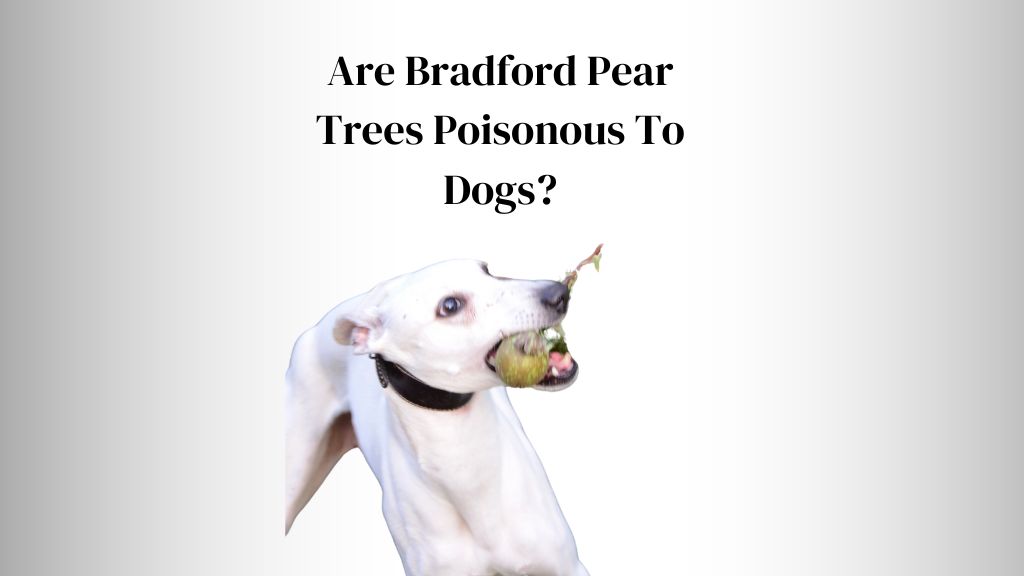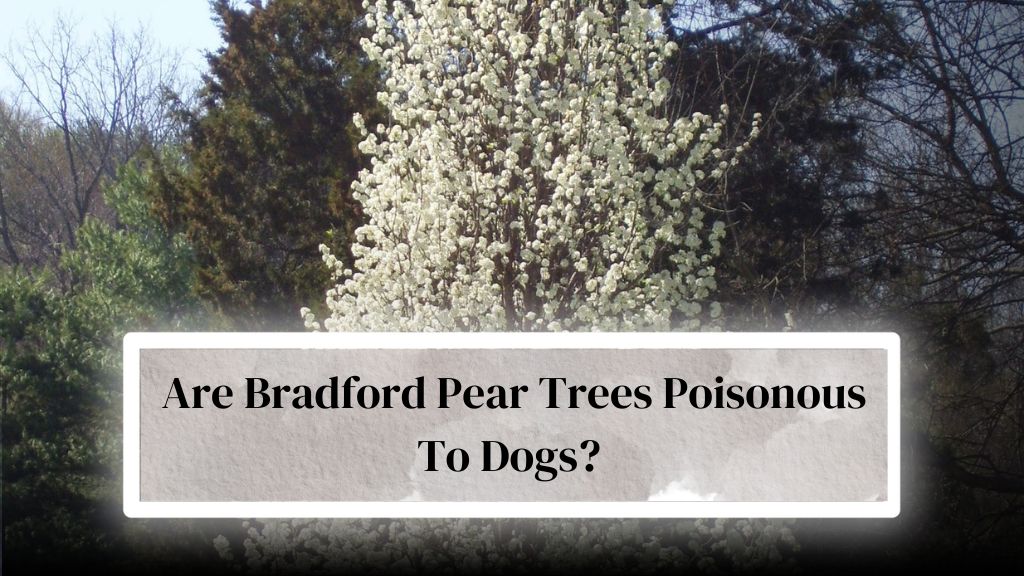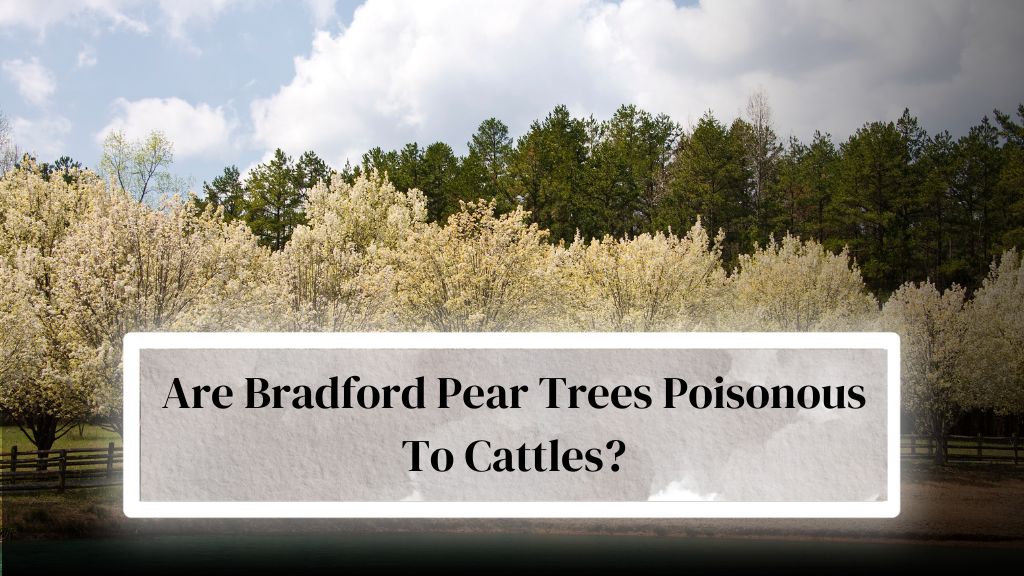
Are Bradford Pear Trees Poisonous? Well, yes, to some extent. You might have noticed that Bradford Pear Trees are a common sight in many neighborhoods & parks. If yes, you may also have seen their beautiful white flowers in the spring or their vibrant red leaves in the fall.
Since they are a popular ornamental tree known for their fast growth and low maintenance, you should grow one in your landscape. Well, before you do that, you must consider its toxicity in the case of pets or cattle.
In this article, I will answer two of the most interesting questions: are Bradford Pear Trees poisonous to dogs, and are Bradford Pear Trees poisonous to cattle? Well, As much as we enjoy the beauty of these trees, it is important to be aware of their potential toxicity to our furry friends. Let’s learn about this in-depth.
Toxicity in Bradford Pear Trees
The Bradford Pear Tree contains an amygdalin chemical that can release Cyanide when ingested by dogs and cattle. You might know that Cyanide is a toxic substance that can cause severe harm to animals and even lead to death.
So, how do these chemicals affect dogs and cattle? We have seen reports of dogs and cattle experiencing symptoms such as vomiting, diarrhea, lethargy, and difficulty breathing after ingesting parts of the tree. These symptoms can vary in severity, depending on how much the toxic substance is ingested.
Are Bradford Pear Trees Poisonous To Dogs?

As a dog owner, I always want to ensure my furry friend is safe from harm. If you have a dog and Bradford Pear Trees in your yard or neighborhood, you may wonder if it is safe to eat parts of the tree. The answer is no; dogs should not eat any part of the Bradford Pear Tree.
Several factors can affect the level of toxicity in dogs. These include the age and size of the dog, the amount of the toxic substance ingested, and the duration of exposure. It is important to note that even a small amount of the toxic substance can harm dogs.
To prevent your dog from eating parts of the Bradford Pear Tree, there are several preventive measures that you can take. One option is to fence off the area around the tree to keep your dog away. You can also supervise your dog while outside and teach them commands to stay away from the tree.
Preventive Measure
Fencing
To prevent your dog from accessing the tree, fence off the area around it. To establish a natural barrier, you can plant additional trees or shrubs or use a physical one like a fence or mesh. To prevent your dog from jumping over the fence, ensure it is high enough.
Supervision
When your dog is outside, keep an eye on them and give them directions to stay away from the tree. Redirect your dog’s focus if they start looking at the tree to a toy or treat. You can also use a leash to keep your dog under control and away from the tree.
Training
By utilizing positive reinforcement strategies, such as treats or praise, you can teach your dog to stay away from the tree. Commands like “leave it” and “stay away” should be taught to them. The secret to successful training is consistency.
Removal
If you are worried about the security of your pets, think about taking down the Bradford Pear Tree. You could change
Secure Tree Trimmings
Promptly clean up and properly dispose of any tree trimmings or branches that fall from the Bradford Pear Tree. This will keep your dog away from the trimmings, which may continue to be poisonous even after being taken from the tree. If you want learn, “how to trim Bradford Pear Trees“, check this article out.
Are Bradford Pear Trees Poisonous to Dogs or Cattle?

As a pet owner or cattle farmer, you may wonder if Bradford Pear Trees are toxic to your animals. According to my research, Bradford Pear Trees can harm cattle if consumed in large quantities. The tree contains a compound called hydrocyanic acid, which is toxic to both humans and animals.
If your cattle ingest the leaves, seeds, or bark of the Bradford Pear Tree, they could exhibit signs including convulsions, difficulty breathing, and foaming at the mouth. In serious circumstances, death is possible.
Although Bradford Pear Trees are typically considered toxic to cattle, the degree of toxicity may differ depending on several factors. The tree’s age, location, and growing circumstances can all affect how much hydrocyanic acid is present.
Furthermore, the stage of growth at which the tree is consumed can also affect the level of toxicity. The leaves and seeds of the tree contain more hydrocyanic acid when they are young and tender.
You can take several preventive measures to protect your cattle from the harmful effects of Bradford Pear Trees. Firstly, remove any Bradford Pear Trees from your pasture or grazing areas. If you’re looking to hire a professional, learn these factors that affect the cost to remove a Bradford pear tree.
Alternatively, you can install a physical barrier around the tree to prevent your cattle from accessing it. You can also ensure that your cattle can access other food sources, such as hay or pasture, to reduce their appetite for the tree.
7 Symptoms of Toxicity in Dogs & Cattle from Bradford Pear Trees
| Symptom | Dogs | Cattle |
|---|---|---|
| Vomiting | ✔️ (may be bloody) | ✔️ |
| Diarrhea | ✔️ (may be bloody) | ✔️ |
| Lethargy | ✔️ | ✔️ |
| Difficulty Breathing | ✔️ | ❌ |
| Seizures | ✔️ | ❌ |
| Loss of Consciousness | ✔️ | ❌ |
| Rapid Heart Rate | ✔️ | ❌ |
What to Do If Your Pet Consumes Bradford Pear Trees
You should take immediate action if you have a dog that has consumed any part of the Bradford Pear Tree. As the pet owner, you must watch your dog and look out for symptoms such as vomiting, difficulty breathing, and seizures.
You should seek veterinary attention immediately if you notice any of these symptoms. It’s essential to provide your veterinarian with as much information as possible about the amount of the tree your dog consumed and the duration since ingestion. Your veterinarian may recommend treatment options depending on the severity of your dog’s symptoms. Treatment may include:
- Inducing vomiting.
- Administering activated charcoal to absorb toxins.
- Providing intravenous fluids to prevent dehydration.
In severe cases, your veterinarian may need to provide additional supportive care, such as oxygen therapy or anti-seizure medication. It’s crucial to follow your veterinarian’s treatment plan carefully to ensure the best possible outcome for your pet.
Alternatives to Bradford Pear Trees
Suppose you’re looking for safe and dog-friendly trees that offer similar benefits to Bradford Pear Trees. In that case, several options are available. For example, you can plant a dogwood tree, a crabapple tree, or a serviceberry tree.
These trees offer similar spring blooms and fall foliage as Bradford Pear Trees without the risk of toxicity to your pets. To know “When Do Bradford Pear Trees Bloom?“, you can this article. When selecting a new tree, you should consider the tree’s size, growing conditions, and maintenance requirements.
Conclusion
After reading this article, you will want to avoid having a Bradford pear tree in your yard or landscape because of its potential toxicity that may harm your pet & castles.
However, if you plan to have these trees, keep them protected from the reach of your pets & cattle. I have given my best to give you all the information you need to know about the poisonous nature of the Bradford pear tree towards pets & castles, along with other wildlife.
If you find this article helpful, then consider sharing it. Your share will help many people learn why they should avoid this particular specimen in the case of dogs or cats.
Check our other helpful guide shared on this website regarding Bradford pear tree care & management that might prove helpful for you. See you in the next post, till then, take care and goodbye.
